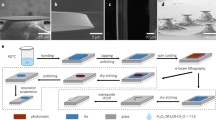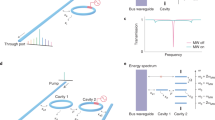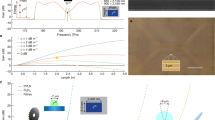Abstract
Signal processing at terahertz speeds calls for an enormous leap in bandwidth beyond the current capabilities of electronics, for which practical operation is currently limited to tens of gigahertz1. This can be achieved through all-optical schemes making use of the ultrafast response of χ(3) nonlinear waveguides2. Towards this objective, we have developed compact planar rib waveguides based on As2S3 glass, providing a virtual ‘lumped’ high nonlinearity in a monolithic platform capable of integrating multiple functions. Here, we apply it to demonstrate, for the first time, a photonic-chip-based, all-optical, radio-frequency spectrum analyser with the performance advantages of distortion-free, broad measurement bandwidth (>2.5 THz) and flexible wavelength operation (that is, colourless). The key to this is the waveguide's high optical nonlinearity and dispersion-shifted design. Using the device, we characterize high-bit-rate (320 Gb s−1) optical signals impaired by various distortions. The demonstrated ultrafast, broadband capability highlights the potential for integrated chip-based signal processing at bit rates approaching and beyond Tb s−1.
This is a preview of subscription content, access via your institution
Access options
Subscribe to this journal
Receive 12 print issues and online access
$209.00 per year
only $17.42 per issue
Buy this article
- Purchase on Springer Link
- Instant access to full article PDF
Prices may be subject to local taxes which are calculated during checkout




Similar content being viewed by others
References
Roberts, K. Electronic dispersion compensation beyond 10 Gb s−1. LEOS Summer Topical Meetings, 9–10 (2007).
Agrawal, G. P. Nonlinear Fiber Optics 3rd edn (Academic Press, 2001).
Ta'eed, V. G. et al. Self-phase modulation-based integrated optical regeneration in chalcogenide waveguides. IEEE J. Sel. Top. Quant. 12, 360–370 (2006).
Salem, R. et al. Signal regeneration using low-power four-wave mixing on silicon chip. Nature Photon. 2, 35–38 (2008).
Yamada, K. et al. All-optical efficient wavelength conversion using silicon photonic wire waveguide. IEEE Photon. Technol. Lett. 18, 1046–1048 (2006).
Olsson, B.-E., Ohlen, P., Rau, L. & Blumenthal, D. J. A simple and robust 40 Gb s−1 wavelength converter using fiber cross-phase modulation and optical filtering. IEEE Photon. Technol. Lett. 12, 846–848 (2000).
Ta'eed, V. G. et al. Error free all optical wavelength conversion in highly nonlinear As–Se chalcogenide glass fiber. Opt. Express 14, 10371–10376 (2006).
Tangdiongga, E. et al. All-optical demultiplexing of 640 to 40 Gbits s−1 using filtered chirp of a semiconductor optical amplifier. Opt. Lett. 32, 835–837 (2007).
Li, J., Olsson, B. E., Karlsson, M. & Andrekson, P. A. OTDM demultiplexer based on XPM-induced wavelength shifting in highly nonlinear fiber. IEEE Photon. Technol. Lett. 15, 1770–1772 (2003).
Ayotte, S., Xu, S., Rong, H., Cohen, O. & Paniccia, M. J. Dispersion compensation by optical phase conjugation in silicon waveguide. Electron. Lett. 43, 1037–1039 (2007).
Kilper, D. C. et al. Optical performance monitoring. J. Lightwave Technol. 22, 294–304 (2004).
Luo, T. et al. All-optical chromatic dispersion monitoring of a 40 Gb s−1 RZ signal by measuring the XPM-generated optical tone power in a highly nonlinear fiber. IEEE Photon. Technol. Lett. 18, 430–432 (2006).
Blows, J. L., Hu, P. & Eggleton, B. J. Differential group delay monitoring using an all-optical signal spectrum-analyser. Opt. Commun. 260, 288–291 (2006).
Westbrook, P. S., Her, T. H., Eggleton, B. J., Hunsche S. & Raybon, G. Measurement of pulse degradation using all-optical 2R regenerator. Electron. Lett. 38, 1193–1194 (2002).
Witte, R. A. Spectrum and Network Measurements (Prentice Hall, 1993).
Dorrer, C. & Maywar, D. N. RF spectrum analysis of optical signals using nonlinear optics. J. Lightwave Technol. 22, 266–274 (2004).
Madden, S. J. et al. Long, low loss etched As2S3 chalcogenide waveguides for all-optical signal regeneration. Opt. Express 15, 14414–14421 (2007).
Lamont, M. R. E., Martijn de Sterke, C. & Eggleton, B. J. Dispersion engineering of highly nonlinear As2S3 waveguides for parametric gain and wavelength conversion. Opt. Express 15, 9458–9463 (2007).
Takahashi, M. et al. Low-loss and low-dispersion-slope highly nonlinear fibers. J. Lightwave Technol. 23, 3615–3624 (2005).
Acknowledgements
This work was in part supported by the Australian Research Council (ARC) through its ARC Centres of Excellence and Federation Fellowship programs.
Author information
Authors and Affiliations
Contributions
All authors have contributed to this paper and agreed on the content.
Corresponding author
Rights and permissions
About this article
Cite this article
Pelusi, M., Luan, F., Vo, T. et al. Photonic-chip-based radio-frequency spectrum analyser with terahertz bandwidth. Nature Photon 3, 139–143 (2009). https://doi.org/10.1038/nphoton.2009.1
Received:
Accepted:
Published:
Issue Date:
DOI: https://doi.org/10.1038/nphoton.2009.1
This article is cited by
-
Real-time gap-free dynamic waveform spectral analysis with nanosecond resolutions through analog signal processing
Nature Communications (2020)
-
Wideband excitation of Fano resonances and induced transparency by coherent interactions between Brillouin resonances
Scientific Reports (2018)
-
Wideband dynamic microwave frequency identification system using a low-power ultracompact silicon photonic chip
Nature Communications (2016)
-
Enhancing and inhibiting stimulated Brillouin scattering in photonic integrated circuits
Nature Communications (2015)
-
Chromatic dispersion monitoring using semiconductor optical amplifier
Frontiers of Optoelectronics (2014)



